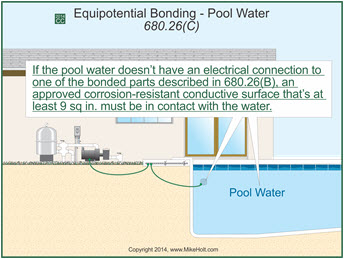|
The NEC® 2014
Section 680.26 Equipotential Bonding
We’re excited to bring you an extract from Mike Holt’s Illustrated Guide to Understanding the NEC®, Volume 2 to give you an introduction to the book and DVDs. As part of our ongoing effort to provide free resources to help the industry, this is our 2nd in a series of newsletters that include graphics and text taken directly from a Mike Holt textbook and a video clip from the DVD program.

Watch the Video Clip!
To get the most out of this instruction, watch the video clip as you review this content. Click here or on the image to the right [duration 19:19]. Mike and the DVD team weigh in on the rule and discuss the practical impact of its everyday application.
In case you missed it, here is the link to the 1st in this series of newsletters: 250.54 Auxiliary Grounding Electrodes.
*Please note in the follwing extraction that red underlined text indicates a 2014 NEC change.
Section 680.26 – Equipotential Bonding |
Author’s Comment:
The bonding requirements of this section don’t apply to spas and hot tubs [680.42].
(A) Performance. The required equipotential bonding is intended to reduce voltage gradients in the area around a permanently installed pool. Figure 680-39

Figure 680-39
(B) Bonded Parts. The parts of a permanently installed pool listed in (B)(1) through (B)(7) must be bonded together with a solid copper conductor not smaller than 8 AWG with listed pressure connectors, terminal bars, exothermic welding, or other listed means in accordance with 250.8(A). Figure 680-40

Figure 680-40
Equipotential bonding isn’t required to extend to or be attached to any panelboard, service equipment, or grounding electrode.
(1) Concrete Pool Shells-Equipotential Bonding.
(a) Structural Reinforcing Steel. Unencapsulated structural reinforcing steel in concrete shells must be bonded together by steel tie wires. Figure 680-41

Figure 680-41
(2) Perimeter Surfaces. Equipotential bonding must extend 3 ft horizontally beyond the inside walls of a pool including unpaved, paved, and poured concrete surfaces. Figure 680-42

Figure 680-42
Author’s Comment:
The NEC doesn’t provide any guidance on the installation requirements for structural reinforcing steel when used as a perimeter equipotential bonding method.
(b) Alternative Means. Where structural reinforcing steel isn’t available (or is encapsulated in a nonconductive compound such as epoxy), equipotential bonding meeting all of the following requirements must be installed: Figure 680-43

Figure 680-43
(1) The bonding conductor must be 8 AWG bare solid copper.
(2) The bonding conductor must follow the contour of the perimeter surface.
(3) Listed splicing devices must be used.
(4) The required conductor must be located between 18 in. and 24 in. from the inside walls of the pool.
(5) The bonding conductor must be secured in or under the deck or unpaved surface within 4 in. to 6 in. below the subgrade.
(3) Metallic Components. Metallic parts of the pool structure must be bonded to the equipotential grid.
(4) Underwater Metal Forming Shells. Metal forming shells and mounting brackets for no-niche luminaires and speakers must be bonded to the equipotential grid.
(5) Metal Fittings. Metal fittings 4 in. and larger located within or attached to the pool structure, such as ladders and handrails must be bonded to the equipotential grid. Figure 680-44

Figure 680-44
(6) Electrical Equipment. Metal parts of electrical equipment associated with the pool water circulating system, such as water heaters, pump motors, and metal parts of pool covers must be bonded to the equipotential grid. Figure 680-45

Figure 680-45
Ex: Metal parts of listed double-insulated equipment aren’t required to be bonded.
(a) Double-Insulated Water-Pump Motors. If a double-insulated water-pump motor is installed, a solid 8 AWG copper bonding conductor must be provided for a replacement motor.
(7) Fixed Metal Parts. All fixed metal parts must be bonded to the equipotential grid, including but not limited to, metal-sheathed cables and raceways, metal piping, metal awnings, metal fences, and metal door and window frames. Figure 680-46

Figure 680-46
Ex 1: If separated from the pool structure by a permanent barrier that prevents contact by a person.
Ex 2: If located more than 5 ft horizontally from the inside walls of the pool structure. Figure 680-47

Figure 680-47
Ex 3: If located more than 12 ft measured vertically above the maximum water level.
(C) Pool Water. If the pool water doesn’t have an electrical connection to one of the bonded parts described in 680.26(B), an approved corrosion-resistant conductive surface that’s at least 9 sq in. must be in contact with the water. The corrosion-resistance conductive surface must be bonded in accordance with 680.26(B), and be located in an area where it won’t be dislodged or damaged or dislodged during normal pool usage. Figure 680-48

Figure 680-48
This Article is extracted from Mike Holt’s Understanding the NEC®, Volume 2 based on the 2014 NEC®. To order your copy of the full program, click on the image below or visit www.mikeholt.com and save 20% when you use discount code NL14DECO.

|



